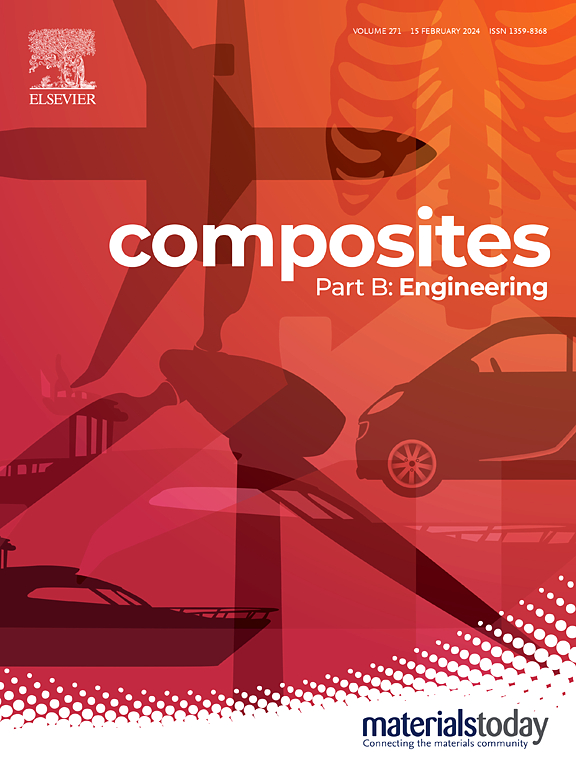用于先进单片软硬机器人应用的可展开纤维增强聚合物
IF 12.7
1区 材料科学
Q1 ENGINEERING, MULTIDISCIPLINARY
引用次数: 0
摘要
可展开结构,特别是那些受折纸启发的结构,因其紧凑的存储和高效的展开能力而获得了极大的关注。本研究提出了一种多树脂分配工艺,用于制造适合软硬机器人应用的单片纤维增强聚合物(FRP)结构。结合刚性和柔性环氧树脂可以实现精确的树脂图案,克服了传统单一树脂系统的局限性。这种方法允许在整体结构中选择性地赋予机械性能,促进部署机制,并确保在重复循环下的稳定性,而不存在滞后。所得FRP结构刚性部分的弯曲模量为6.95 GPa,可折叠部分的弯曲模量为0.66 GPa,允许曲率半径小于0.5 mm的选择性折叠。三角圆柱形折纸(TCO)结构单片复合材料的成功制造,突显了先进FRP结构大规模生产的潜力,适用于下一代软硬机器人和航空航天应用。与现有的软材料不同,TCO FRP在高达80%的高应变下反复展开,可产生2.75 kgf的显著展开力,从而实现重复运动。这一进步扩大了复合材料的范围,促进了具有选择性刚性和灵活性的适应性,可扩展的解决方案。本文章由计算机程序翻译,如有差异,请以英文原文为准。
Deployable fiber-reinforced polymer for advanced monolithic Rigid–Soft robotics applications
Deployable structures, particularly those inspired by origami, have garnered significant attention for their compact storage and efficient deployment capabilities. This study proposes a multi-resin dispensing process for fabricating monolithic fiber-reinforced polymer (FRP) structures tailored for rigid–soft robotics applications. Combining rigid and flexible epoxy resins enables precise resin patterning, overcoming the limitations of traditional single-resin systems. This approach allows the selective imparting of mechanical properties within monolithic structures, facilitating deployment mechanisms and ensuring stability under repetitive cycles without hysteresis. The resulting FRP structures exhibit a flexural modulus of 6.95 GPa for rigid sections and 0.66 GPa for foldable sections, allowing selective folding with a radius of curvature less than 0.5 mm. The successful fabrication of a monolithic composite with a triangulated cylindrical origami (TCO) structure highlights the potential for mass production of advanced FRP structures, suitable for next-generation rigid–soft robotics and aerospace applications. Unlike existing soft materials, the TCO FRP demonstrates durability under repeated deployments at high strains of up to 80 %, producing a significant deployment force of 2.75 kgf, enabling repetitive motion. This advancement broadens the scope of composite materials, facilitating adaptable, scalable solutions with selective rigidity and flexibility.
求助全文
通过发布文献求助,成功后即可免费获取论文全文。
去求助
来源期刊

Composites Part B: Engineering
工程技术-材料科学:复合
CiteScore
24.40
自引率
11.50%
发文量
784
审稿时长
21 days
期刊介绍:
Composites Part B: Engineering is a journal that publishes impactful research of high quality on composite materials. This research is supported by fundamental mechanics and materials science and engineering approaches. The targeted research can cover a wide range of length scales, ranging from nano to micro and meso, and even to the full product and structure level. The journal specifically focuses on engineering applications that involve high performance composites. These applications can range from low volume and high cost to high volume and low cost composite development.
The main goal of the journal is to provide a platform for the prompt publication of original and high quality research. The emphasis is on design, development, modeling, validation, and manufacturing of engineering details and concepts. The journal welcomes both basic research papers and proposals for review articles. Authors are encouraged to address challenges across various application areas. These areas include, but are not limited to, aerospace, automotive, and other surface transportation. The journal also covers energy-related applications, with a focus on renewable energy. Other application areas include infrastructure, off-shore and maritime projects, health care technology, and recreational products.
 求助内容:
求助内容: 应助结果提醒方式:
应助结果提醒方式:


